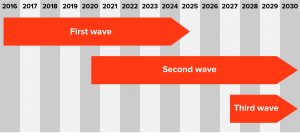Ericsson Mobility Report 2021
As the Ericsson Mobility Report reaches its 10th anniversary, we’d like to reflect on some of the key trends and events identified in the report that have shaped the last decade. Mobile technology has transformed with infrastructure moving from 4G toward 5G to support the ever-increasing technology usage, in line with Moore’s Law of exponential growth.
Mobile Network Advances
The 5G network coverage momentum is set to continue, with 5G services already covering an estimated 2 billion people. By the end of Ericsson’s forecast period (2027), it is estimated that 5G will make up 75% of the global population’s coverage. This has put the wheels in motion for 2G and 3G legacy technologies to eventually retire; what the industry refers to as “sunsetting”.
The closing down of 2G and 3G has been separated into three different “waves”.
In the UK and Europe, due to large dependencies on 2G, the 3G frequencies have been the first to be “sunsetted”, with an expected completion in the mid-2020s. The sunset of 2G will be expected closer to 2030 according to Ericsson.
Growth in Technology and Data Usage
It’s easy to see how our increasing demand for connectivity grows – mobile networks carry almost 300 times more mobile data traffic compared to 2011. Between 2020 and 2021 alone, mobile network data traffic grew 41%, with this growth attributed to the increasing number of smartphone subscriptions, and the increasing amount of data that the average person uses daily.
Interestingly, this jump in data usage is primarily attributed to video streaming as opposed to any other service. The Ericsson Report has estimated that on a global scale, the average smartphone user requires a minimum of 11.4GB on a monthly basis. This is not least due to the reliance on mobile networks to stay connected, and the increasing population that works from home. In Central and Eastern Europe, Ericsson projects that this figure will increase to 32GB/month by the end of 2027.
Smartphones account for 77% of all mobile phone subscriptions, with nearly 8 billion smartphone contracts forecasted by the end of 2027. More than 180 service providers have launched commercial 5G services globally, targeting China and North America due to the dwindling costs of 5G devices. At the close of 2021, it is estimated that there are more than 660 million 5G subscriptions, with 5G handsets accounting for 23% of global volumes. The Ericsson Report estimates that over the span of the next two years 5G will exceed 1 billion subscribers, set to beat 4G records.
The amount of data offered by mobile packages continues to rise, but service providers are looking to provide more options for consumers. ‘Service-based connectivity’ add-ons are becoming increasingly popular as an alternative to unlimited packages, targeting specific services such as social media, music and video streaming.
Additionally, over 75% of service providers are now offering fixed wireless access (FWA) services, which is styled as a scalable alternative to wired solutions. This represents a growth of roughly 25% over the last 6 months alone. 12% of these service providers offer a QoS, which usually entails “speed tiers”, enabling higher monetization like fibre-based broadband services. The report estimates that by 2027, FWA will offer broadband to over 800 million people.
What does this mean for the Infrastructure and Utilities Sectors?
Fundamentally, that we will continue to see demand for mobile connectivity to grow rapidly. With the rapid adoption of digital technology across all areas of projects, having the best possible connectivity is changing from a ‘nice to have’ to being an absolute necessity. This need will only increase as projects demand full site-wide connectivity to enable the use of emerging technologies, such as connected and autonomous equipment that require the transfer of significant amounts of data to operate. As such, great mobile connectivity is essential to enable the technologies that will make projects safer and more efficient, and its clear that the early adopters in this regard will be true pioneers as infrastructure truly embraces the digital age.
If you would like to discuss how Onwave can support you with connectivity solutions, you can get in touch at sales@onwave.com, or by calling (+44) 203 434 2100.
If you would like to learn more, the Ericsson Mobility Report of November 2021 is available here.









